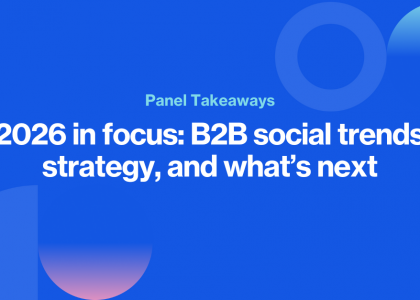Social media content in B2B marketing is about starting conversations that guide, inform, and generate mutual value. But even great content can disappear into the algorithm without making an impact if it isn’t accessible.
When that happens, it’s a loss for content creators because it limits their reach. Even worse, poor accessibility can give the impression that a brand doesn’t care about making its content available to people who cannot see the text and images and are using tools that read the posts out loud. If your social media channels are frustrating for users with disabilities, over 70% of them will simply click out. And it’s not just them: many users prefer to scroll social media with their volume turned down or in noisy environments. If they can’t consume your content on their terms, chances are they won’t consume it at all.
How to embed social media accessibility in every single post
Thankfully, social media platforms equip businesses with all the accessibility features they need to ensure their content is created with everyone in mind and for everyone to engage with.
“Alt text” for images
Adding alt text (alternative text) can make your images more accessible as long as the text is descriptive, succinct, and contextual. The goal is to convey the purpose of the image without being wordy. For example: “A person using a laptop wearing a hoodie” is concise but not very informative. “A hacker using a laptop attempting a cyber attack” gives more information and context, but it’s still easy to understand. Remember to avoid redundancy: there’s no need to start with “An image of…” since users already know they’re getting an image description. Many social media publishing tools offer the capability to add alt text for images.
Captioning for videos
While video descriptions improve accessibility to some degree, your video content is not truly accessible unless it includes captions. Captions are vital for users who cannot hear audio well, whether due to disability, a noisy environment, or simply wanting to browse social media without sound.
Use platform-specific tools like SRT files for Facebook or auto-captioning features on Instagram, and remember to edit your captions so they’re accurate and the timing is right. Review any auto-generated captions before publishing because mistakes happen, and if your brand is mentioned, it would be very embarrassing to have the name spelled incorrectly….
Readable content
Keep your text content plain and jargon-free to make it understandable for everyone. This is social media, after all. Expand acronyms on the first use, like “SEO (Search Engine Optimization),” to avoid confusion. It’s also good to go for high color contrast and accessible fonts to ensure readability, even for low-vision users.
Platform-specific accessibility features
Social media platforms want your published content to be accessible to the broadest possible audience, so each platform offers its own set of tools to boost accessibility.
Facebook allows you to add alt text to images, ensuring visually impaired users can understand your content through screen readers. For videos, upload SRT files to include captions or use the platform’s built-in captioning tools. When creating Reels or Stories, use accessibility options like text overlays and captions to make content more inclusive.
On Instagram, you can write custom alt text for images to provide precise descriptions for visually impaired users. To add subtitles, use accessibility stickers, such as “Auto-Captions,” in Stories and Reels. Avoid using hard-to-read fonts or low-contrast colors in Stories; these can reduce readability.
Twitter/X
To make your tweets more accessible, add alt text to images, offering concise and descriptive explanations. Use Camel-Case hashtags. Capitalize the first letter of each word like this: #AccessibleSocialMedia. This is easier for screen readers to pronounce than lower-case hashtags like #accessiblesocialmedia. This slight adjustment makes a big difference for users relying on assistive technology.
For LinkedIn video posts, add captions by uploading SRT files or enabling auto-captioning. This can lead to up to 15% more video views on LinkedIn. You should also include image descriptions to make your visual content accessible. Use professional but plain language to cater to a diverse audience. Short sentences without fluff tend to get read more often than long, wordy posts.
Keeping your social media inclusive: Tools and resources for testing accessibility
Accessibility is an ongoing commitment, not a one-and-done task. You must test continually to ensure you’re not excluding would-be leads from your audience. With the right tools, you can keep your finger on the pulse without drastically increasing your team’s workload.
Here are some handy tools and strategies to keep your content inclusive and user-friendly:
WebAIM: Offers guidelines and resources to improve web accessibility, including actionable insights for social media.
WAVE: A browser extension that identifies accessibility errors and provides tips for fixing them in your content.
NVDA: A free screen reader for Windows that lets you test how visually impaired users navigate your content.
VoiceOver: A built-in screen reader for Mac and iOS devices that evaluates content accessibility on Apple platforms.
In addition to these tools, feedback can be gathered from users who rely on assistive technology. Pair this with regular accessibility audits to identify and fix issues that are limiting the reach of your social media content.
Reach more, engage more: accessible social media pays off
Making your social media accessible isn’t just a feel-good move. It’s a strategically smart one, too. When you create content everyone can see or hear and then use and enjoy, including people with disabilities, you expand your audience and show that your brand strives for inclusivity. Users might not consciously notice accessibility when it’s done right, but they feel it. When it’s missing, they notice. Regulators might take note, too.
ADA: Digital accessibility is a requirement, not an option
The Americans with Disabilities Act (ADA) has increasingly been applied to digital spaces, including social media platforms and content. Although the law doesn’t specifically name social media, Department of Justice guidance has affirmed that websites and online tools must be accessible to individuals with disabilities. Making your content ADA-compliant isn’t just a way to avoid penalties (although it can do that). It’s also a chance to demonstrate your commitment to equitable access.
Section 508: a model for accessibility standards
While Section 508 primarily applies to federal agencies, its standards set a strong example for private organizations. If you’re creating digital content, especially as a government contractor or partner, meeting Section 508 requirements ensures you align with best practices. These include providing alternatives for multimedia, guaranteeing compatibility with screen readers, prioritizing accessible design, and treating Section 508 as a benchmark to make your social media content more inclusive and position your brand as forward-thinking and socially responsible.
Making accessibility a priority shows regulators (and your audience) that you’re serious about creating equitable and engaging digital experiences.
What’s in store for social media accessibility in 2025?
The future of social media accessibility is bright, driven by technological advancements, evolving legal frameworks, and platform improvements. AI-powered tools, like real-time captioning and voice recognition, are becoming more intelligent, enabling content creators to make posts accessible with minimal effort. These tools can provide accurate captions and even image and video descriptions in real-time.
Regulatory bodies are also placing greater emphasis on digital inclusivity. Legal requirements like the ADA and international standards push businesses to prioritize accessibility in their online presence.
Finally, social media platforms themselves are also stepping up, offering users enhanced accessibility features to simplify the creation of inclusive content, ensuring that no audience is left behind.
Inclusive social media: the path to better connections
Making your social media accessible is not, first and foremost, about meeting legal requirements or even protecting your reputation. It’s about creating meaningful connections with your entire audience.
That’s why making the best use of all available accessibility features should be a cornerstone of your B2B marketing strategy. This calls for continual testing and adaptability, always keeping the user’s needs front and center.
By adopting this approach, forward-thinking businesses are contributing to building a more inclusive digital sphere and ensuring their long-term brand success.




